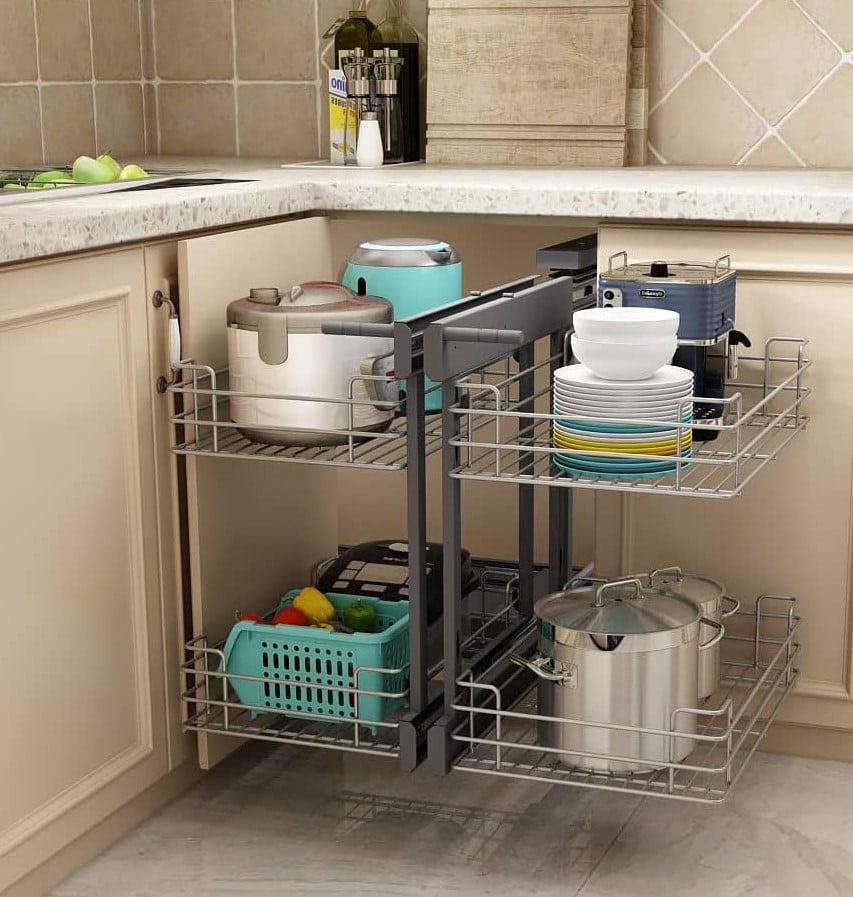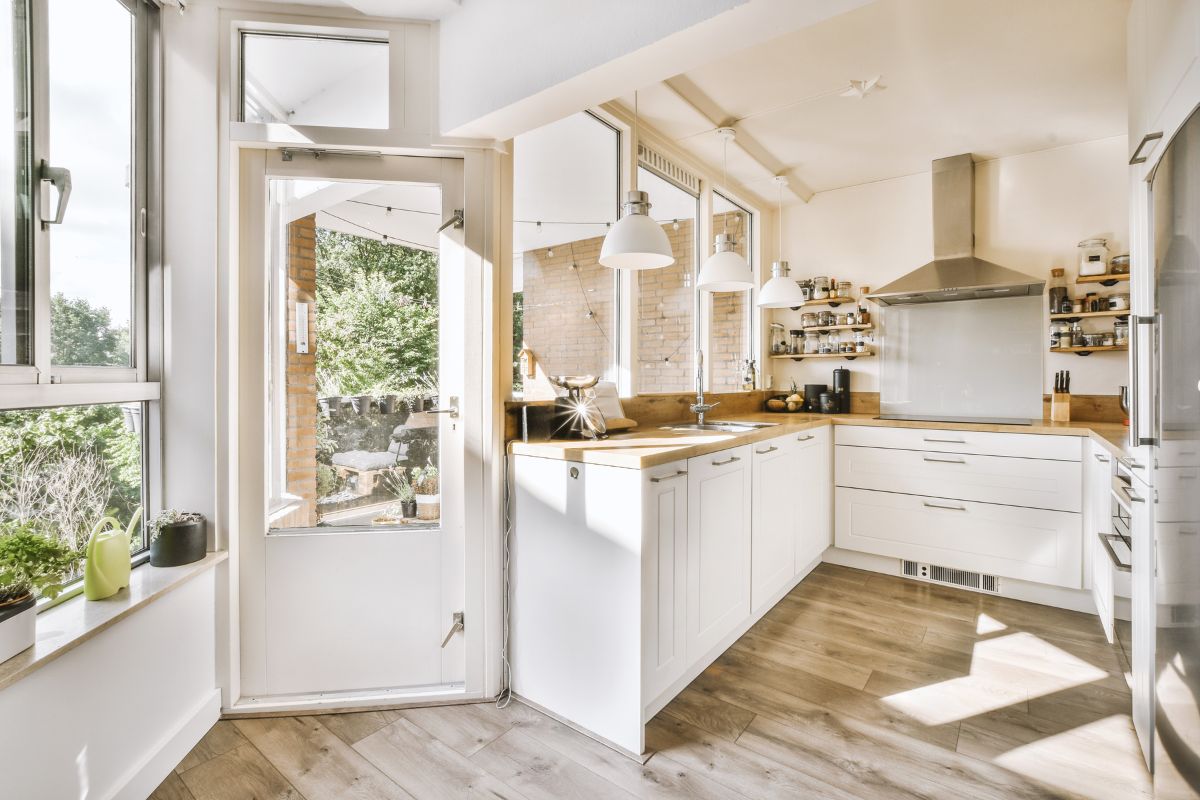Every home cook knows the value of a well-organized kitchen. But even the most spacious kitchens have limits, and the corners are often the most underutilized.
Thankfully, with innovative design techniques, these overlooked spaces can become valuable real estate for storing pots, pans, and other kitchen essentials. Corner kitchen storage solutions not only maximize space but also improve the functionality of your kitchen.
Things to Look Out For

When considering corner kitchen storage, it’s essential to address a few key factors:
- Space Measurement: The size and depth of the corner play a crucial role in determining which storage solution will fit best. Accurate measurements ensure a seamless fit and efficient use of space.
- Accessibility: Consider how often you’ll need to access the items you plan to store in the corner. Opt for solutions that provide easy reach, especially for frequently used items.
- Budget: As with any home improvement project, budget constraints can influence your options. Fortunately, there are corner storage solutions to fit almost every budget.
- Aesthetic Preference: Your kitchen’s decor matters. Your chosen storage solution should blend seamlessly with your kitchen’s design aesthetic.
Pros and Cons of Corner Kitchen Storage
Pros
- Space Maximization: The most evident benefit is the optimal utilization of otherwise wasted corner spaces.
- Enhanced Organization: Many corner storage options come with compartments, tiers, or separate shelves, making it easier to organize items.
- Increased Property Value: A well-organized and efficient kitchen can enhance the overall value of your home.
Cons
- Potential Cost: Some customized corner solutions can be expensive, especially when opting for high-end materials or intricate designs.
- Installation Complexity: Depending on the design, the installation might require professional help, reducing the cost.
- Maintenance: Some moving parts, like those in Lazy Susans or pull-out shelves, may wear over time and require repair or replacement.
Top Corner Kitchen Storage Ideas
Open Corner Shelving

Open corner shelving embodies a blend of rustic charm and contemporary functionality. Gone are the days when kitchen storage meant closed, wooden cabinets that hid away your cherished crockery or unique spice jars. With open shelving, the kitchen embraces a paradigm where functionality meets display.
The very nature of open shelving fosters a sense of responsibility, nudging homeowners towards regular tidying and organization. Additionally, for those who appreciate the aesthetics of their kitchenware, these shelves serve as a canvas to showcase their personality, from artisanal pottery to heirloom dishes passed down through generations.
Features
- Versatility: These shelves can accommodate a wide range of items, from decorative ceramics and plants to essential everyday kitchenware.
- Airy Feel: The open design ensures that the kitchen feels spacious and uncluttered, preventing the heaviness that sometimes comes with closed cabinets.
- Ease of Access: Without doors or drawers to navigate, grabbing what you need becomes instantaneous, ideal for busy cooking sessions.
Built-in Wine Racks

Built-in wine racks in a kitchen corner are more than just storage; they’re a testament to a homeowner’s palate for fine wines and their knack for elegant design. These racks merge the world of oenophiles with interior design, turning a mere storage solution into an art display.
For wine enthusiasts, the value of a bottle isn’t just in its taste but also in its story. Displaying organized wines allows for easier categorization by region, age, or grape variety. Every time they reach for a bottle, they journey through their collection’s history.
Features
- Customizability: Depending on your collection size, the rack can be tailored to accommodate a varying number of bottles.
- Safety: These racks are designed to store wine bottles at the correct angle, ensuring the cork remains moist, and the wine stays in prime condition.
- Aesthetic Appeal: The visual arrangement of wine bottles can be both artistic and a conversation starter when entertaining.
Floating Corner Shelves
With their ethereal appearance, floating corner shelves usher in an era of modern, minimalist kitchen design. The absence of obtrusive brackets or visible supports lends an air of mystery, making one wonder about the magic that holds up these platforms.
Beyond their chic appearance, these shelves are a testament to efficient design. Despite the lack of visible support, their strength allows homeowners to place various items on them. Whether it’s the gleam of glass jars filled with colorful spices or the green of fresh potted herbs, these shelves cater to both form and function.
Features
- Space-saving: They utilize vertical space efficiently, allowing for multiple storage tiers.
- Clean Aesthetics: With hidden mounting hardware, they offer a discreet look emphasizing the items placed on them.
- Flexibility: Suitable for decorative and functional purposes, these shelves can hold anything from potted herbs to dishes.
Corner Sink with Underneath Storage
At the intersection of innovation and ergonomic design lies the corner sink with underneath storage. Traditionally, corners were blind spots in kitchen design, but with this setup, they become the focal point, transforming dead space into a hub of activity.
The storage beneath is a treasure trove of organization. Imagine pull-out racks that house cleaning essentials or ingeniously designed bins for waste segregation. This design ensures that every inch, even in the remotest corner, serves a purpose, elevating the kitchen’s overall efficiency.
Features
- Ergonomic Design: Positioned at an angle, the corner sink can be more comfortable, reducing the need for excessive reaching or bending.
- Enhanced Workflow: The underneath storage can be customized with pull-out bins or racks, ensuring cleaning essentials are at arm’s length.
- Space Efficiency: The unique design might allow for larger sink basins, while the under-sink storage cleverly hides cleaning products or waste bins.
Pull-out Corner Pantries

Pull-out corner pantries redefine the essence of space utilization in modern kitchens. Their design is a subtle nod to the age-old adage: “There’s more than meets the eye.” They might seem slender and unassuming, but a gentle pull reveals layers of well-organized shelves, each holding a myriad of kitchen essentials.
What’s remarkable about these pantries is their adaptability. They cater to the diverse needs of a modern kitchen, housing everything from tall cereal boxes to tiny spice jars.
The pull-out mechanism ensures that even the most elusive ingredient tucked away in a corner is never out of reach. It’s a design that champions accessibility without compromising aesthetics.
Features
- High Storage Capacity: Despite their slender appearance, these pantries can hold many goods, from cereals and spices to baking essentials.
- Easy Access: The pull-out mechanism ensures every item is visible and within reach, eliminating the need to rummage through dark, cluttered cabinets.
- Space Conservation: Their design ensures minimal footprint, making them perfect for smaller kitchens where space is at a premium.
Corner Kitchen Storage Ideas: FAQs
Absolutely! Corner storage solutions are particularly beneficial for small kitchens where space optimization is crucial. Solutions like pull-out corner pantries or floating corner shelves can maximize storage in limited spaces.
The maintenance largely depends on the material and design. For instance, wooden shelves may require periodic polishing, while metal racks require occasional dusting. Pull-out mechanisms should be checked for smooth operation and might benefit from occasional lubrication. Always refer to manufacturer guidelines for specific care instructions.
Organizing items based on the frequency of use is vital. Store frequently used items at eye level or within easy reach, while less frequently used items can be stored higher up or deeper within the unit. Using clear containers or labels can also help in quickly identifying contents.



